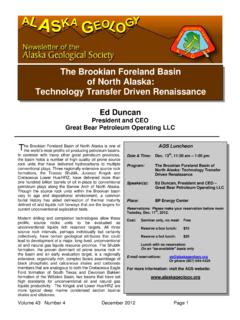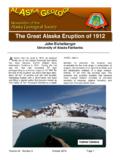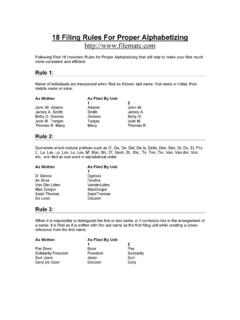Transcription of Neotectonics of a Complex Plate Boundary Zone: …
1 Volume 43 Number 9 May 2013 Page 1 Neotectonics of a Complex Plate Boundary Zone: indentation , rotation , and Escape in Alaska Wes Wallace Geophysical Institute / Department of Geology & Geophysics, UAF AGS Luncheon Date & Time: May 16th, 11:30 am 1:00 pm Program: Neotectonics of a Complex Plate Boundary Zone: Indenta-tion, rotation , and Escape in Alaska Speaker(s): Wes Wallace, UAF Place: BP Energy Center Reservations: Make your reservation before noon Tuesday, May 14th, 2013. Cost: Seminar only, no meal: Free Reserve a box lunch: $15 Reserve a hot lunch: $20 Lunch with no reservation: On an as-available basis only E-mail reservations: or phone (907) 564-4028 For more information: visit: Convergence of thick crust of the Yakutat block with the southern margin of Alaska is widely recognized as a domi-nant influence on the tectonics of Alaska since at least late Miocene time.
2 It is less clear how this convergence relates to the distribution, type, and orientation of geologic struc-tures, and to the boundaries between the tectonic provinces that they define. We propose that convergence of Yakutat block includes two distinct components that influence defor-mation and topography in different ways: 1) The crust of the exposed, southern Yakutat block is too thick to subduct, which has caused the collisional St. Elias orogen. Detachment of the upper part of the mafic base-ment allows delamination and sinking of the remaining mafic crust and lithospheric mantle. The collisional orogen drives rigid counterclockwise rotation of the southern Alaska block south of the arcuate, right-lateral Denali fault. The western Boundary of this block is a zone of distributed contraction in the western Alaska Range and Cook Inlet. (continued) View to the northwest of Denali (20,320 ft, 6,194 m) and Mt.
3 Foraker (17,400 ft, 5,304 m), the high points of a high massif in the central Alaska Range. The incised plateau in the foreground is part of the Talkeetna Mountains, a topographic high that spans the projected position of the fore-arc basin. The Denali massif, the Talkeetna Mountains, and a gap in the magmatic arc correspond with gently dipping subducted Yakutat crust. View to the northeast of the two highest peaks of the collisional St. Elias orogeny, Mt. St. Elias (right, 18,008 ft, 5,489 m) and Mt. Logan (left, 19,551 ft, 5,959 m). Yahtse Glacier (foreground) terminates at sea level just out of the picture to the right. The tremendous topographic relief of Mt. St. Elias is apparent because it is only 20 km from a marine shoreline. Volume 43 Number 9 May 2013 Page 2 About the Speaker: Wes Wallace has worked on the structural geology and tectonics of Alaska since 1975, when he began his project on the Border Ranges fault east of the Trans-Alaska Pipeline.
4 He worked with ARCO in An-chorage (1981-1985) on the regional tectonic framework and evolution of Alaska, with emphasis on south-western Alaska and the Brooks Range. In 1985, he moved to the University of Alaska Fairbanks, where his focus has been on fold-and-thrust structures, mainly in the Brooks Range. In recent years, he and his stu-dents have worked on the young tectonics of the northern Alaska Range and the Fairbanks area. In this talk, Wes summarizes an interpretation of the young tectonic framework of Alaska that he has developed over the years that he has worked throughout Alaska and taught a graduate class on the geologic evolution of Alaska. 2) The northern part of the Yakutat block is thin enough to subduct but thick and buoyant enough to cause localized flat-slab subduction orthogonal to rotation of the southern Alaska block. Consequences include the gently antiformal Talkeetna Mountains that span the forearc basin, a gap in the magmatic arc, and a base-ment-involved fold-and-thrust belt in the northern Alaska Range.
5 An arcuate oroclinal hinge from southern Alaska to the northeastern Brooks Range reflects indentation since at least Paleocene time. Traction above the subducted Yakutat block along the southern part of this hinge drives current indentation . North of the subducted Yakutat block, indentation is reflected by left-lateral block rotation that accommodates shortening between the Denali and Tintina faults and by contraction farther north along the northern edge of the arcuate northeastern Brooks Range. Western Alaska accommodates both northward indentation and westward convergence of the southern Alas-ka block by right-lateral block rotation and tectonic escape related to local left-lateral faults. Farther west, slow clockwise rigid rotation of the extensive Bering block accommodates escape and is separated from sta-ble northwestern Alaska by a zone of extension.
6 These tectonic provinces are defined by mapped structures and by the distribution and focal mechanisms of earthquakes. Structures are generally consistent with stress orientations determined from earthquakes, but local discrepancies between observed structures and those predicted from the stress determinations suggest that reactivation of older structures is important. Interpretive map of Neogene faults and basins of mainland Alas-ka and northwestern Canada. Fault colors indicate knowledge of Neogene activity: Yellow: known; red: suspect; blue: un-known, but active some time between Late Cretaceous and pre-sent. Orange indicates Eocene and younger basins. CSE: Chugach-St. Elias. Based on Neotectonic Map of Alaska (Plafker et al., 1994) and other published sources. Relation of Yakutat block collision and subduction to faults and magmatic arcs in south-central Alaska.
7 Contours: light blue: depth to Wadati-Benioff zones ; red: thickness of Yakutat crust (from Worthington et al., 2012, JGR). Abstract from: Wallace, , and Ruppert, N., 2012, Young tectonics of a Complex Plate Boundary zone: indentation , rotation , and escape in Alaska: American Geophysical Union fall meeting, San Francisco, CA, Abstract T14A-08, 3 December, 2012. Volume 43 Number 9 May 2013 Page 3 Scholarship Update Experimental insights into the formation of amphibole reaction rims: Texture, mineralogy, and processes of formation (Partial Funding: Alaska Geological Society Scholarship) Sarah Henton, University of Alaska Fairbanks Amphibole is an important mineral present in many calc-alkaline volcanic deposits. A hydrous phase, volcanic amphibole is only stable at pressures greater than ~100 MPa (approx. 4 km) and in melts containing at least 4 wt % H2O.
8 When removed from their thermal and barometric stability field, am-phiboles decompose to form aggregate rims of anhydrous minerals. Reaction rim thicknesses have been used to estimate timescales and rates of magma ascent, an important parameter in determin-ing eruptive style. However, the process of reaction rim formation is Complex ; numerous magmatic properties exert a control on the reaction process ( magma compositions and viscosities) and multiple forcing factors may be responsible for their formation ( heating, decompression, or changes in magma chemistry). Due to a lack of experimental work, amphibole reaction rims are a poorly understood and commonly misused source of information of magmatic processes. This experimental study at the University of Alaska Fairbanks, funded in part through the generosity of the Alaska Geological Society, presents one of the first in-depth, systematic, and quantitative in-vestigations of reaction rim textures and mineralogy.
9 During a series of experiments, amphiboles were subjected to differing degrees of thermal or barometric instability, over different time scales, ranging from 3 144 hours. The resulting reaction rims were analyzed using a variety of analytical imaging and X-ray mapping techniques. The results of this study, which are currently being prepared for publication, show that a range of different processes can contribute to the formation of amphibole reaction rims. A key result is that the mineralogical and textural features of many experimental heat-ing-induced amphibole reaction rims are indistinguishable from natural reaction rims attributed by past studies to decompression (and subsequently used to infer magma ascent rates). Composite X-Ray maps of experimental amphibole reaction rims. Reactions depicted were all formed at a temperature of 900oC and at a pressure of 140 MPa.
10 Successive images reflect increasing experiment durations: A) 3 hours; B) 6 hours; C) 12 hours; D) 24 hours; E) 36 hours; F) 48 hours. Different colors depict different minerals. Exact shading varies between images but in general: blue = glass; purple = plagioclase; red = magnetite; yellow = ilmenite; olive green = amphibole; green = orthopyroxene; yellow/green = clino-pyroxene. Images show how amphibole reaction rims increase in width and also in textural and minerological complexity as heating duration is increased. Volume 43 Number 9 May 2013 Page 4 ALASKA FOSSIL OF THE MONTH SAPELNIKOVIELLA SANTUCCII A NEW ALASKAN SILURIAN BRACHIOPOD GENUS AND SPECIES IS BORN Robert B. Blodgett (Consulting Geologist, Anchorage, Alaska) This month s selection for the Alaska Fossil of the Month is a newly described brachiopod Sapelnikoviella san-tuccii Blodgett, Baranov, Boucot, and Rohr, 2013 (see Figure 1) from the upper Silurian Willoughby Limestone on Drake Island in Glacier Bay, Southeast Alaska (see Blodgett et al.














